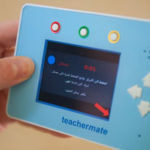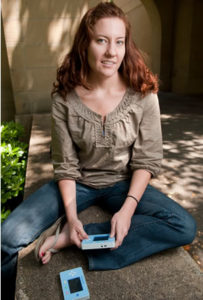
The stories are harrowing, but Elizabeth Buckner hopes sharing accounts of the tension among Palestinians and Israelis with the help of mobile devices will offer perspective to children from both sides and promote understanding in the volatile region.
Buckner, a doctoral student at Stanford University’s School of Education, heads a group of volunteers who collect everyday stories from children who detail their experiences in disputed areas, road checkpoints, and border regions between Israel and Palestine.
The kids’ stories will be recorded and downloaded onto mobile devices that will be distributed at schools in Israel and the Palestinian territories. Buckner said the children’s stories—which range from details of family gatherings and sporting events to close calls with Israeli soldiers—soon will be available as a free iPhone application.
“Our idea is to use technology to think about how to help, not just academically,” said Buckner, 26, who finished her second year in Stanford’s doctoral program this spring. “We want to take a big-picture approach to how technology can meet social problems and social needs. And this is an area of the world with so much need.”
The devices—called TeacherMates, from the Illinois-based nonprofit Innovations for Learning (IFL)—double as video game players loaded with lessons in reading and basic math, among other subjects. They also have a built-in microphone for students to record their stories in their own voices. Each unit costs about $100 per student, and Stanford’s School of Education has partnered with IFL to bring TeacherMates to indigent rural communities around the globe.
Buckner joined Paul Kim, the School of Education’s chief technology officer, when she traveled to the West Bank early this year to meet with activist groups, educators, and local officials, who helped arrange interviews with students. Researchers at Birzeit University in the West Bank are creating Arabic content to be used with the mobile devices.
Buckner said the Stanford contingent worked with nonprofit groups and translators to document children’s experiences.
The mobile devices will be aimed primarily at the youngest age groups, Buckner said, because many elementary-school students haven’t been exposed to enough contention yet to solidify their views on the decades-old conflict.
“We want to get kids at younger ages before they develop such negative ideas and opinions, and while they’re still malleable, because what a lot of them have witnessed is really shocking,” she said. “By the time they’re teenagers, they already have ideas of how things are. … Our real hope is to be able to share stories and hold values of forgiveness.”
Buckner said the project team collected about 100 stories from children, and four have been added to a reservoir of narratives that Stanford officials hope to expand when they visit the West Bank and Israel next fall or winter. Her group traveled to the West Bank during Passover—when Israeli schools are out—so they haven’t been able to record accounts from Israeli students yet.
One of the stories distributed via mobile device comes from a 15-year-old Palestinian boy. He and his classmates had piled into a bus after they finished exams when they were stopped at an Israeli checkpoint.
The boy said the exchange between a soldier and a student became heated. Then the soldier lifted his gun and fired into the air. Some of the students threw rocks at the Israeli soldiers, the boy said, and the soldiers rounded up the students and beat them until a few students had to be taken to the hospital, the student said.
“Some of us won’t forget this for the rest of our lives,” the boy said, according to Buckner.
Another story is from a Palestinian fourth-grader who, along with two friends, learned that an area of the West Bank was now off limits.
The boys were herding sheep near an Israeli settlement when they were approached by Israeli soldiers, who told the boys they were too close. The fourth-grader stayed with the oldest boy, a 17-year-old, despite the teenagers’ pleas for the boy to run away as the soldiers approached.
“The younger generations are exposed to [increased] polarization among the two sides,” Buckner said, “so these stories are meant to help them think about the problems … and using [mobile technology] was an engaging way to do that.”
Mobile-phone usage in the Palestinian territories has risen in recent years, with eight in 10 households now having access to mobile devices, according to a report from the United States Agency for International Development.
Buckner said the Stanford-connected nonprofit group, Seeds of Empowerment, will make the children’s stories available for free on the organization’s web site.
- Research: Social media has negative impact on academic performance - April 2, 2020
- Number 1: Social media has negative impact on academic performance - December 31, 2014
- 6 reasons campus networks must change - September 30, 2014

